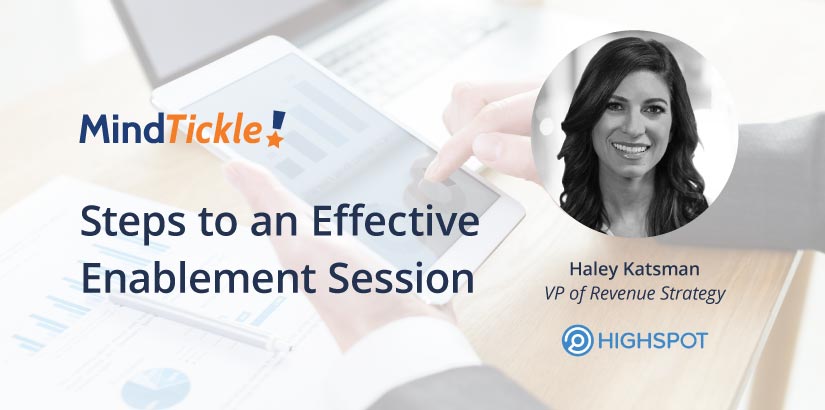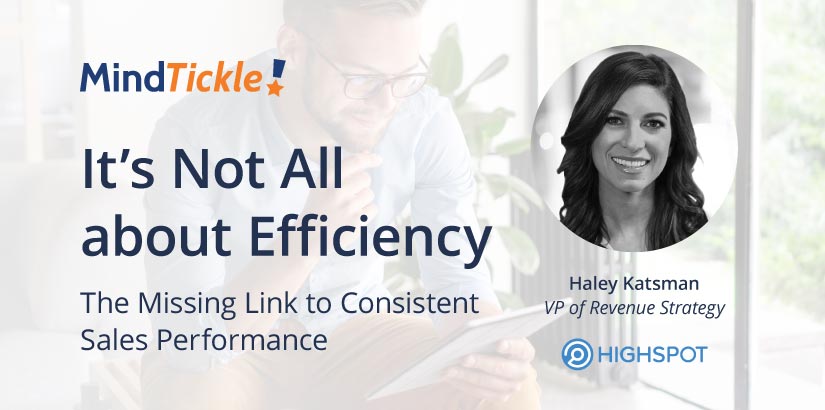Steps to an Effective Enablement Session
Most strategic revenue initiatives fail – research from Bridges Consultancy found that 67 percent of well-formulated strategies fail due to poor execution. When only five percent of employees understand their company’s strategy, it’s not hard to see why. Employees don’t want to execute strategies that they don’t understand or feel connected to.
What can enablement leaders do to help teams become more effective in executing strategies? Planning alone is not enough – you have to give your teams the resources, oversight and support needed to bring your strategies to life. Follow these steps to effective sales enablement that will provide your enablement and sales leaders, as well as salespeople, with the tools, knowledge, and motivation they need to turn your company’s strategies into action.
Lay the groundwork for success
Before you pull your reps off the floor for the next training exercise or activity, ensure alignment and support from sales leadership. It is important to proactively address natural skepticism about enablement initiatives and ensure that sales leadership understands how you will help improve their team’s effectiveness.
Provide visibility and seek feedback early and often – sales leaders can help identify potential objections that you may have missed. They can also help you articulate the WIIFM – what’s in it for me – to help you “sell the seller” and land the desired outcomes of training. Ask sales leadership to partner with you on holding their teams accountable for leveraging the new training and practicing it in the field while measuring impact. Soon your teams will look forward to your training, knowing just how much value it brings.
Ask and address key questions
Great outcomes start with a great understanding of what you’re looking to accomplish. Before you begin building your plays and training content, you need to have a clear vision of the business goal and the outcomes you are striving to impact. This will also help you measure the ROI of your enablement efforts. To ensure your training and sales plays resonate and land, ask six foundational questions:
- What is the business goal?
- Examples: Increase win rate, grow pipeline, shorten deal cycle, customer retention, etc.
- Who is my internal audience
- Examples: Sales, account management, customer success, etc.
- Who is our target customer?
- Examples: Industry, company size, region, buyer persona, etc.
- Who are my play builders?
- Examples: Product marketing, sales enablement, front-line sales manager
- When should the training be put into action?
- Examples: In the discovery phase, during customer implementation, etc.
- What’s in it for the sellers?
- Examples: Hit quota faster, increase ASP to close fewer deals, recognition from leadership, etc.
Having strong answers to these questions will be essential in getting buy-in and feedback from your sales managers. Further win over managers by determining If you can plug into an existing sales event, rather than creating a new one.
To motivate sellers and increase engagement during the training, assign pre-work and reading before the training begins. A blended framework that includes pre-work, self-paced content, virtual role-play and webinars create an engaging training experience. For example, having a sales leader record a video that demonstrates a best-in-class pitch or demo is a great way to keep learners engaged. Self-paced voice-over slideshows and pre-recorded videos that teach information and show what great looks like can help with pre-training engagement. Save the live training session for discussions and Q&A.
With clear goals, managers on your side, and an established training format, you’ll have laid the foundation for effective enablement.
During the training
We’ve all been met with lackluster stares during our training sessions before – a primary reason for lack of engagement is your sellers not understanding what’s in it for them. In their eyes, you may be taking an hour away that could have been spent generating more leads, or even time they would have rather spent making prospecting calls. It’s your job to “sell the sellers” and convince them that your training will help them drum up higher quality leads in the same – or even less – the amount of time.
Capture attention immediately by previewing your next-generation sales play. Gone are the days of traditional, one-size-fits-all playbooks – a dynamic sales environment demands a dynamic playbook. With advanced sales enablement technology, you can provide your sellers with plays that contain both content and guidance designed to prepare your team what they need to know, say, show, and do in every unique selling scenario.
Make your session interactive and engaging. Ask questions, have sellers share their stories, or breakout into groups for activities to help connect the dots between the training and action. With the right play and training delivered in an interactive, audience-first way, your salespeople will begin to look forward to your sessions, knowing the knowledge provided will ultimately make them, and the company, more successful.
After the training
As impactful and inspiring as your training might have been, salespeople are busy juggling dozens of tasks a day. Unless your training is reinforced and muscle memory is built in the field, it will quickly be forgotten.
Promote the play or training materials via multiple channels such as email, your CRM, and your sales enablement platform, so that it’s easily accessible where reps spend their time. To overcome the forgetting curve that naturally happens after training, it’s important to include spaced reinforcement of knowledge and training after the event to ensure reps have adopted product messages and have time to internalize that information. Ongoing training will also play a critical role. You might provide courses, quizzes, coaching sessions and more directly within your sales enablement platform to help your reps stay sharp on their skills.
In order to gauge your enablement effectiveness, you can measure key metrics that indicate whether or not your training landed internally and helped reps take off externally with their customer conversations. Metrics like sales play adoption, curriculum completion, and pitched content performance can all be indicators of enablement success. In addition, use technology to request feedback on what worked, what didn’t work and what could be improved moving forward. Showing that you heard and acted on feedback will make sellers more likely to show up, engage and share.
Turning strategies into action
Even the best strategies are rendered useless without execution.
Enablement plays an essential role in ensuring customer-facing teams not only understand the strategies, but are committed to executing them in a way that drives business results. Get started with Highspot’s new eBook How to Enable Revenue Teams with Plays that Turn Strategy Into Action.



